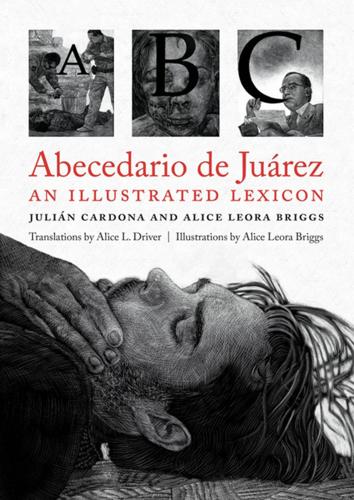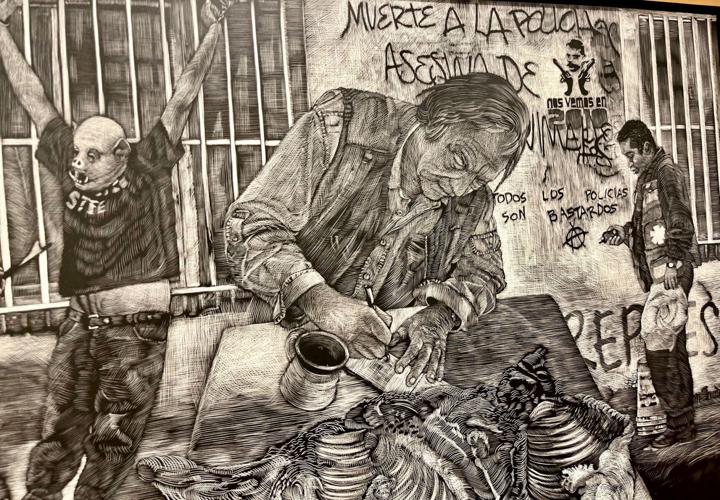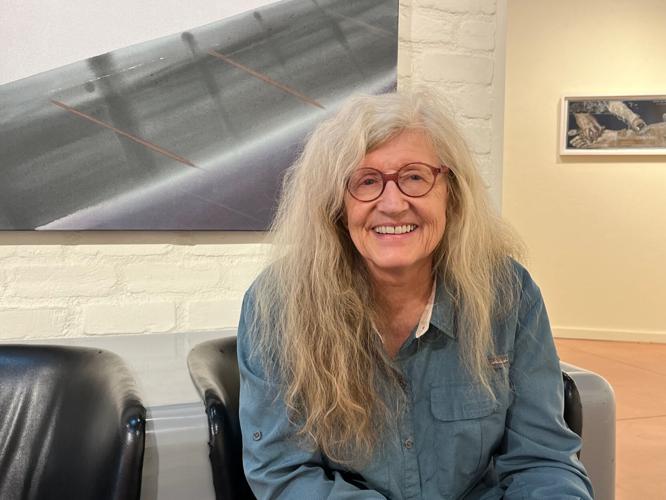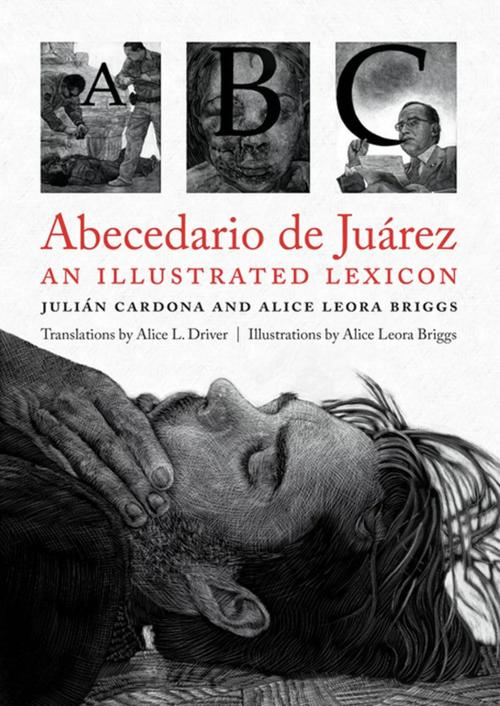The writing is on the wall today for one of Tucson’s oldest and most important institutions. Really. On the wall, and there’s nothing ominous about it.

Artwork by Alice Leora Briggs hangs in the Etherton Gallery, part of an exhibit called “El Sueño de Razón,” or “The Sleep of Reason,” in Tucson on Oct. 18. The show runs through Nov. 25.
Instead, words on the walls have brought thousands of visitors to the ongoing exhibition at the Etherton Gallery in the Old Barrio downtown.
The exhibit includes a collection called “El Sueño de Razón,” or “The Sleep of Reason,” by Alice Leora Briggs, and an untitled array of text art by Kitty Brophy. All 45 pieces display or represent words, and visitors can’t help but feel the power of language … especially when magnified by art.
The show will run through Nov. 25, and gallery owner Terry Etherton is delighted with the response so far.
“In many ways these artists are very different,” he said. “The work on the wall doesn’t look anything alike. But from other perspectives, there is overlap and dialogue here. Both of these women are fearless. They’re dealing in areas most people aren’t comfortable with, and they’re letting us into very private worlds. They’re baring their souls, in a way.”
Visually, the two sets of works are strikingly dissimilar. The sgraffiti by Briggs are images scratched through black to shades of grey. The offerings from Brophy are big and bright, with black words popping from a brilliant red background.
Briggs’ selections illustrate the book she co-authored with Julián Cardona, “Abecedario de Juárez,” or “Alphabet of Juarez,” which was published by the University of Texas Press last year.

In the Alice Leora Briggs and Julián Cardona book “Abecedario de Juárez,” Briggs pays homage to Charles Bowden by placing him at the end of a coroner's table. The image is called "Necessary Tools."
At its heart, the book is a lexicon of the Spanglish slang that evolved in the criminal world that so dominated life in Juarez the first two decades of the 2000s — particularly during the presidency of Felipe Calderón.
Briggs and Cardona — an award-winning photographer and journalist best-known for his images of Juarez — identified more than 200 words. Many are brought to life by Briggs sketches, others by Cardona’s interviews.
“The book doesn’t have a standard format,” Briggs said. “You can open it anywhere and see words that became part of a city’s language. Then they explode into a story. It’s a minefield of language.”

Alice Leora Briggs
Many Tucsonans may remember that Briggs collaborated with the late Charles Bowden, the well-known author and journalist who chronicled the violence along our southern border. Briggs illustrated one of his most iconic books, “Dreamland: The Way Out of Juarez,” which was published in 2010.
Both were absorbed in their own projects in Juarez when Briggs’ husband suggested a possible partnership. “My husband had never met Chuck, but he thought my images looked like Chuck’s writing.”
Interestingly, “Dreamland” includes several sketches Briggs had made before they met … and before he started writing the book. “That’s how closely our stuff dovetailed,” she said.
It was Bowden who introduced Briggs to Cardona … at the Etherton Gallery in 2007. After completing “Dreamland,” Briggs began working with Cardona on “Abecedario.”
The book became a labor of love, and then — when Cardona died of Parkinson’s in 2020 — a product of heartbreak. In the end, Briggs was both author and illustrator, working from the interviews and reporting provided by her friend.
Briggs and Brophy both consider themselves artists rather than writers, yet …
“I’ve written my whole life,” Briggs said. “I wrote for the Reader in Chicago and the Salt Lake Tribune when I worked at Utah State.”
Brophy majored in creative writing at UC-Santa Cruz.
“Growing up, I was one of those weird kids who read dictionaries and did spelling bees,” she laughed. “I’ve always loved language. I’ve always loved words.”
One of her pieces on the wall at the Etherton is evidence of that. “It’s 2020, Bi***” shows a random assortment of words that caught Brophy’s attention during the early stages of the pandemic.
“Instead of writing an essay about what I was feeling, I just wrote down words … words that jumped out at me when we were all trapped at home. Between the pandemic and the election, there was so much coming at us. People were making up new words just to describe it all.”

Kitty Brophy
Because all of us remember the experience, and each of us weathered it in different ways, no two people will be drawn to the same words in Brophy’s “2020.”
Similarly framed yet differently presented is another new Brophy offering: “The Book of Female Don’ts.” This time we see sentences … advice and cultural cues that girls and women hear throughout their lives.

A portion of “The Book of Female Don’ts” by Kitty Brophy hangs in the Etherton Gallery.
“I grew up with four sisters and five female cousins who lived next door,” Brophy said. “We’ve all talked about the messaging girls get from the media, from movies, from people we know. Sometimes I catch myself repeating these things because they’re so ingrained. I’m 63 now, so imagine how much of it I’ve heard.”
Again, no two women will be drawn to the same two sentences in Brophy’s “Book.”
Although Briggs and Brophy both live in Tucson, they hadn’t met until introduced by Etherton before their show opened last month.
Now … well, let’s hope this isn’t their last two-woman show. The writing is already on the wall.
FOOTNOTES
Author Kianna Alexander will be featured at the Pima County Public Library’s annual LGBTQ+ Author Talk this Sunday, Oct. 22, at the Loft Cinema. The event will go from 5 to 6:30 p.m. and include a conversation between Alexander and the library’s Jessica Pryde. Alexander’s latest books are “Can’t Resist Her” and “Can’t Let Her Go.” Learn more at tucne.ws/1ofw.
Sharon O’Brien has been named the new executive director at Literacy Connects. Hers is a familiar face there. She has headed the Stories That Soar program since the organization was founded in 2011. O’Brien replaces Matt Tarver-Wahlquist, who resigned last November.
Novelist Shelby Van Pelt will be the featured guest when the Tucson Festival of Books unveils its first list of authors who will take part in the festival in the spring. The program will be Dec. 3 at the University of Arizona, but details have not been finalized. Van Pelt authored one of the summer’s most surprising hits, “Remarkably Bright Creatures.”
Beverly Fisher opened Light | Space, her gallery/studio art space at 307 S. Convent Ave. in the Barrio Viejo neighborhood. Her focus is fine craft and art, which is minimal and nonrepresentational. On view right now is artwork by Bonnie Lynch and Linda Lynch.
The exhibition runs through December. The gallery is open Wednesday through Saturday, 12:00p.m. - 5:00p.m. Video by: Mamta Popat, Arizona Daily Star










